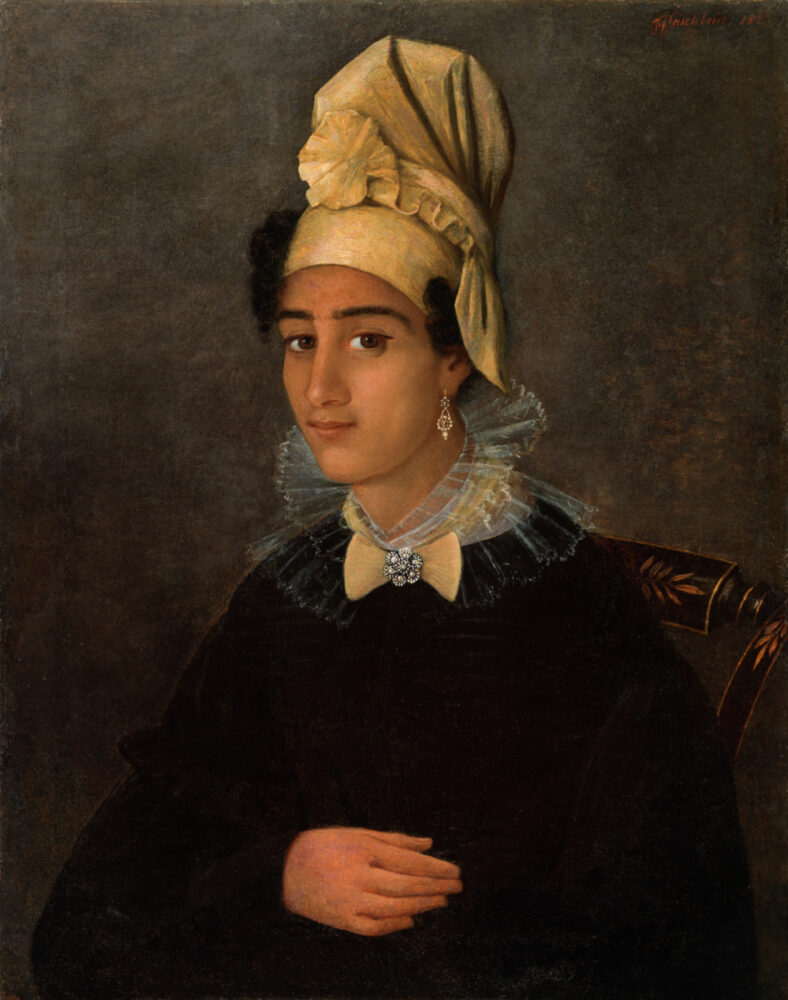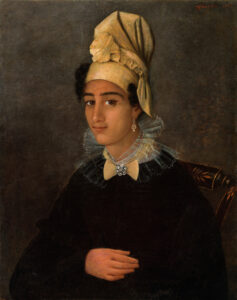Free People of Color in Colonial Louisiana
In colonial Louisiana free people of color developed thriving communities and had access to privileges that enslaved people did not.
This entry is 6th Grade level View Full Entry

The Historic New Orleans Collection
Portrait of a Free Woman of Color by François Jacques Fleischbein.
Free people of color—known as gens de couleur libres in French—formed a distinctive segment of Louisiana’s population from the French colonial period through the 1860s. Most free people of color resided in New Orleans and spoke French as their first language. French-speaking free people of color also lived in rural areas, especially in St. Landry, Natchitoches, Pointe Coupee, and St. Martin Parishes.
Within Louisiana’s slave society, free Black people existed between enslaved people of African descent and free white people. They had access to a set of privileges denied to enslaved people, including property ownership, education, freedom of movement, and use of the legal system.
How did Louisiana’s community of free people of color develop?
Louisiana’s free people of color population developed during the colonial era. The earliest record of a free Black person in New Orleans dates from 1722, three years after the first ship arrived with enslaved Africans to French Louisiana. The Black Code, or Code Noir, recognized the category of “free persons of color.” Louisiana’s version of the Code Noir included measures meant to discourage the development of a large free Black population. Manumission—when an enslaver legally freed an enslaved person—required approval from the Superior Council, colonial Louisiana’s legislative body. The code prohibited marriages and other relationships between white and Black people. However, records from the period indicate that such relationships did occur and that colonial authorities had difficulty enforcing this law. In addition, free people of color could be re-enslaved if found assisting enslaved individuals who freed themselves by running away.
Despite the Code Noir’s restrictions, a slow growth in the numbers of free people of color in New Orleans and the surrounding area resulted from manumissions and immigration. Some of the earliest free Black inhabitants came to Louisiana as free people. Marie Baude, for example, traveled to New Orleans from Senegal in 1728 to reunite with her French husband. Yet most free people of color during the French colonial period experienced enslavement. For example, Louis Connard, his wife Catherine, and their four children were owned by Jacques Coustilhas, who manumitted the enslaved family in his will. Following the death of Coustilhas, Connard successfully petitioned Governor Jean-Baptiste Le Moyne, sieur de Bienville, to approve his family’s freedom in 1739.
Manumission records indicate that enslaved women and children gained their freedom more often than enslaved men. Because the status of children followed that of their mother, the free Black population grew as enslaved women gained their freedom and had children.
Some enslaved men received their freedom for performing necessary services for the government. Louis Congo, for example, negotiated for his freedom in exchange for serving as the colony’s executioner. François Tiocou gained freedom for militia service, fighting with the French against Native Americans in retaliation for the 1729 Natchez Revolt.
How did Spanish rule affect the community of free people of color in Louisiana?
The number of free people of color increased significantly in Spanish Louisiana. By the end of the French period, there were 400 to 800 free people of color in New Orleans and the surrounding area. Forty years later this number reached more than fifteen hundred. Frontier regions like Attakapas, Opelousas, and Natchitoches also saw small, growing numbers of free Black people during the Spanish period. This dramatic growth was due to Spanish policies that encouraged the development of a free Black population in the colony. Compared to the French, the Spanish made it easier for enslavers to manumit an enslaved person.
In addition, enslaved people had the right, under Spanish law, to initiate their own manumissions through a self-purchase process known as coartación. Unlike the French, the Spanish also allowed enslaved men and women to own personal property, including money made from selling goods or services performed on their own time. Working as a barrel maker, Noel Carriere used his savings to purchase his freedom in 1771. Margarita Trudeau, who sold goods, used her earnings to buy her son’s freedom in 1782.
Through hard work and determination, enslaved people used these laws to their advantage. Between 1771 and 1803, 1,921 men, women, and children gained their freedom through voluntary manumissions and self-purchase in New Orleans. Coartación made up most of these emancipations.
More women than men gained their freedom through all manumission methods. In New Orleans free women of color outnumbered free men of color throughout the colonial era and into the nineteenth century.
Free people of color in Spanish New Orleans were often skilled property owners. Common professions for men included carpentry, construction, ironworking, and making furniture, shoes, and clothes. Women worked as seamstresses, laundresses, midwives, tavern keepers, boarding house keepers, and retailers, among other jobs. They commonly invested the income from these occupations in property, owning land, homes, and sometimes enslaved people. Property ownership provided free Black people financial security and a way to build wealth across generations. When baker Francisca Montreuil died in 1803, her children and grandchildren inherited five enslaved people, a house in New Orleans, two plantations, farm animals, and furniture.
The Spanish enlarged the free Black militia in New Orleans to include more than 450 members by 1801. Militia members defended the colony, assisted in emergencies, and pursued enslaved people who found freedom by running away. During the American Revolution, free Black soldiers fought with Governor Bernardo de Gálvez against the British in Florida.
